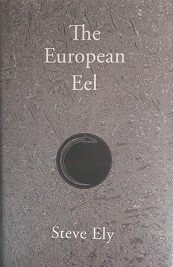Review of The European Eel by Steve Ely, pub. Longbarrow Press 2021

When Steve Ely remarks that his name caused him to be “chosen” by the European eel as a chronicler, I doubt he is being entirely facetious. George Herbert, after all, was convinced that if “son” and “sun” were homonyms, this must be because the Lord, for some good reason, wished it to be so. Ely does nothing half-heartedly and having decided to write a book-length eco-poem centring on the endangered eel, his first act was to make an exhaustive study of its life, habitat and history. The result of this is that he is very much at home with the scientific vocabulary – geographic, oceanographic, biological – attaching to it. And being Ely, he sees no reason to avoid using this because it might be esoteric or unfamiliar to the reader. He does provide an informative glossary and notes at the end, which can profitably be read after the poem, but personally I would first read straight through, immerse yourself in this Sargasso of fascinating new words and rely on the meaning becoming clear enough from the context.
For one thing, the lingering on the tongue of lines like “leptocephalus, the larval form of anguilla” and “the thermonuclear/microplankton of the drifting epipelagic” pave the way for the sudden brutality of his description of the Gulf Stream, in which the same verbal euphony belies the words’ meaning:
a roaring salt river
hurtling north on the edge of the American
continental shelf, its estuaries of blight;
oestrogen-saturated sewage, methamphetamine
neurotoxins, chromosome-warping
neocotinoid run-off. The leptocephali soak it up
and tumble to Hatteras with the flotsam
of the current – single-use Canaveral
space junk, the strip mall’s car-tossed,
fast-food trash and radioactive manatees.
He focuses on one individual eel’s journey from her birth in the Sargasso Sea to a Yorkshire pool and back again – eels breed in the Sargasso and find their way there from all the various European rivers and streams where they have spent most of their lives. Having made this epic journey and bred, they die. This eel’s odyssey encompasses, beside natural predators, the blades of hydro-electric plant turbines, potentially fatal pollutants like benzoylecgonine, found in the tissues of eels in cities where cocaine use is high, and indeed Mr Ely himself, who temporarily removes her from her habitat to make a study before re-releasing her.
Obviously the journey, though based on extensive research, is largely imagined, and some of the imagining creates startlingly effective imagery:
rippling spearheads
of foliate gelatine, glittering in the half-lit heave
like a shoal of shredded cling-film.
Its single-minded purpose also generates terrific momentum. One danger of eco-poetry is that it can sound like a sermon or lecture. This poem never stands still long enough for that: the ways in which humans are casually fouling up the eel’s world are noted, deadpan and laconically, as she travels, never dwelt on – after all, new hazards are arising at every turn and demanding attention. Power pulses through these lines like the eels through the water, never more so than at the literal climax, when the eel finally mates:
the hypertonic waters are smoking
with milt, and her shuddering body
can hold it back no longer. She cracks like a whip
and her body convulses, spurting gusher
after gusher of glittering golden ova.
Another way to get eco-poetry wrong is to make it so gloomy and doom-laden that it is no fun to read – as Brecht so aptly remarked, if you want to educate or persuade an audience, you must first give them an incentive to sit still. Here the incentive, apart from the intrinsic interest of the eel’s journey, is the joyfulness and delight of Ely’s language. He has always enjoyed diving into an ocean of words, and rarely has this trait been more appropriate than in this poem. In an earlier collection, Incendium Amoris, I occasionally found the allusiveness and linguistic exuberance detracting from the momentum. In The European Eel there is such a narrative drive that the passing allusions to other endangered or extinct former inhabitants of the earth, like right whales, passenger pigeons and evicted Gaelic crofters, speed by and become part of the poem’s landscape as if we were glimpsing them through the window of an express train.
Fortunately this particular train can be boarded again and again, and the details of the journey noted more carefully. This is, I think, his most consistently powerful and entertaining book for a while, and certainly one of the most impressive books of eco-poetry I have read.



